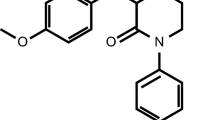Abstract
Objective
To assess the differences in the pharmacokinetics and cardiac safety of ebastine and its active metabolite, carebastine, in patients with normal and impaired renal function.
Methods
Twenty-four patients with varying degrees of renal impairment (mild, moderate or severe: n = 8 per group) and 12 healthy subjects participated in an open-label, parallel-group, multicentre study. Ebastine 20mg was administered orally once daily for 5 days. Plasma concentrations of ebastine and carebastine were determined for 24 hours on day 1 and for 72 hours on day 5 by using a validated sensitive liquid chromatography-tandem mass spectrometry assay with a minimum quantifiable limit of 0.05 ng/mL for ebastine and 1.00 ng/mL for carebastine. Renal function was assessed by measuring 24-hour creatinine clearance (CLCR) at baseline. Cardiac and general safety parameters were also monitored.
Results
The pharmacokinetics of ebastine were not modified by renal impairment. No correlation between ebastine pharmacokinetics and renal function, as expressed by CLCR assessed 2 days prior to dosing, was observed. Comparison of the plasma exposure and the elimination half-life of ebastine and carebastine between groups showed no significant differences. Therefore, no apparent accumulation of ebastine and carebastine occurred, and steady-state concentrations of ebastine and carebastine were predictable from single-dose pharmacokinetics for both healthy subjects and patients with renal impairment, even though the variability between the groups was large. In addition, no differences were observed in the safety of ebastine between patients with renal impairment and healthy subjects when assessing adverse events, vital signs, laboratory parameters or ECGs.
Conclusion
Ebastine was generally well tolerated in subjects with impaired renal function. No clinically important pharmacokinetic or safety differences were observed between patients with renal impairment and healthy subjects with normal renal function.









Similar content being viewed by others
References
Vincent J, Liminana R, Meredith PA, et al. The pharmacokinetics, antihistamine and concentration-effect relationship of ebastine in healthy subjects. Br J Clin Pharmacol 1988; 26(5): 497–502
Martinez-Tobed A, Tarruús E, Segura J, et al. Pharmacokinetic studies of ebastine in rats, dogs and man. Drugs Today (Barc) 1992; 28 Suppl. B: 57–67
Yamaguchi T, Hashizume T, Matsuda M, et al. Pharmacokinetics of the H1-receptor antagonist ebastine and its active metabolite carebastine in healthy subjects. Arzneimittelforschung 1994; 44(1): 59–64
Hashizume T, Mise M, Terauchi Y, et al. N-Dealkylation and hydroxylation of ebastine by human liver cytochrome P450. Drug Metab Dispos 1998; 26(6): 566–71
Aventis Pharmaceuticals Products, Inc. An open-label, single dose pharmacokinetic study of ebastine 20mg in volunteers with severe renal insufficiency. Bridgewater (NJ): Aventis Pharmaceuticals Products, Inc., 1994. (Data on file)
Wilson J, Huang MY, Argenti D, et al. Comparative pharmacokinetics of carebastine/ebastine in moderately renally impaired and healthy volunteers following a single 10mg dose of ebastine: PPDM-8370 [abstract]. Pharm Res 1993; 10 Suppl. 10: S390
Woosley RL. Cardiac actions of antihistamines. Annu Rev Pharmacol Toxicol 1996; 36: 233–52
Estelle F, Simons R. H1-receptor antagonists: safety issues. Ann Allergy Asthma Immunol 1999; 83(5): 481–8
Horak F, Stubner UP. Comparative tolerability of second generation antihistamines. Drug Saf 1999; 20(5): 385–401
US FDA. COSTART: Coding Symbols for Thesaurus of Adverse Reaction Terms. 3rd edition. Rockville (MD): FDA, 1989
Malik M. Problems of heart rate correction in assessment of drug-induced QT interval prolongation. J Cardiovasc Electrophysiol 2001; 12(4): 411–20
Chaikin P, Gillen MS, Malik M, et al. Co-administration of ketoconazole with H1-antagonists ebastine and loratadine in healthy subjects: pharmacokinetic and pharmacodynamic effects. Br J Clin Pharmacol. 2005; 59(3): 346–54
Malik M. Effects of supratherapeutic doses of ebastine and terfenadine on the QT interval. Br J Clin Pharmacol 2002; 54(6): 682–3
Wagner JG. Drug accumulation. J Clin Pharmacol 1967; 7: 84–8
Settipane RA. Demographics and epidemiology of allergic and nonallergic rhinitis. Allergy Asthma Proc 2001; 22(4): 185–9
Tripathi A, Patterson R. Impact of allergic rhinitis treatment on quality of life. Pharmacoeconomics 2001; 19(9): 891–9
Hurst M, Spencer CM. Ebastine: an update of its use in allergic disorders. Drugs 2000; 59(4): 981–1006
Acknowledgements
This study was supported in part by a grant from Rhône-Poulenc Rorer (Collegeville, PA; now Sanofi-Aventis). Almirall Prodesfarma (Barcelona, Spain) is the originator of ebastine and is now responsible for its development. The clinical centres to which Robert Noveck, Richard Preston and Suzanne Swan are affiliated received grant research support from Rhône-Poulenc Rorer to conduct the investigation; however, no direct funds were paid to these authors.
Robert Noveck was the principal investigator in this study, and Rhône-Poulenc Rorer was primarily responsible for study protocol development and management, analysis and interpretation of the study data. The authors thank Almirall Prodesfarma for statistical review of this manuscript. The authors also wish to thank Michelle Tracy of Prous Science, who provided medical writing and editorial assistance on behalf of Almirall Prodesfarma.
Author information
Authors and Affiliations
Corresponding author
Rights and permissions
About this article
Cite this article
Noveck, R.J., Preston, R.A. & Swan, S.K. Pharmacokinetics and Safety of Ebastine in Healthy Subjects and Patients with Renal Impairment. Clin Pharmacokinet 46, 525–534 (2007). https://doi.org/10.2165/00003088-200746060-00006
Published:
Issue Date:
DOI: https://doi.org/10.2165/00003088-200746060-00006




